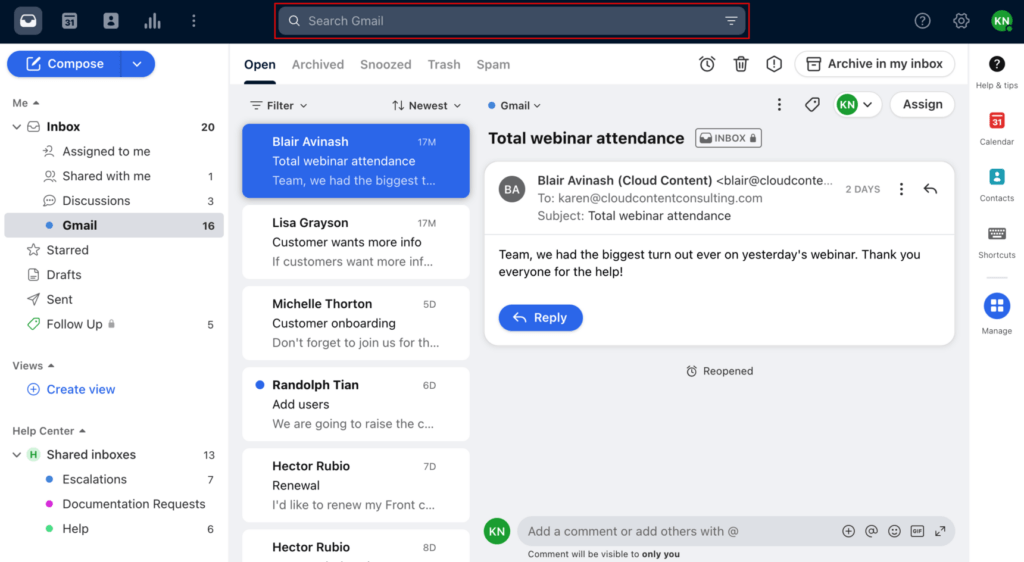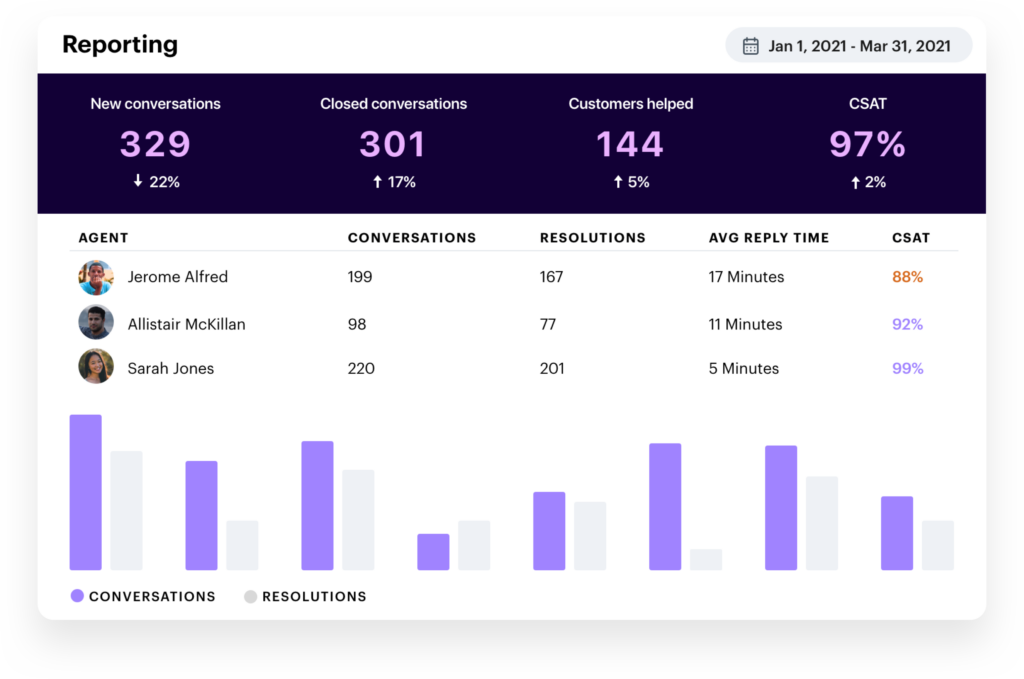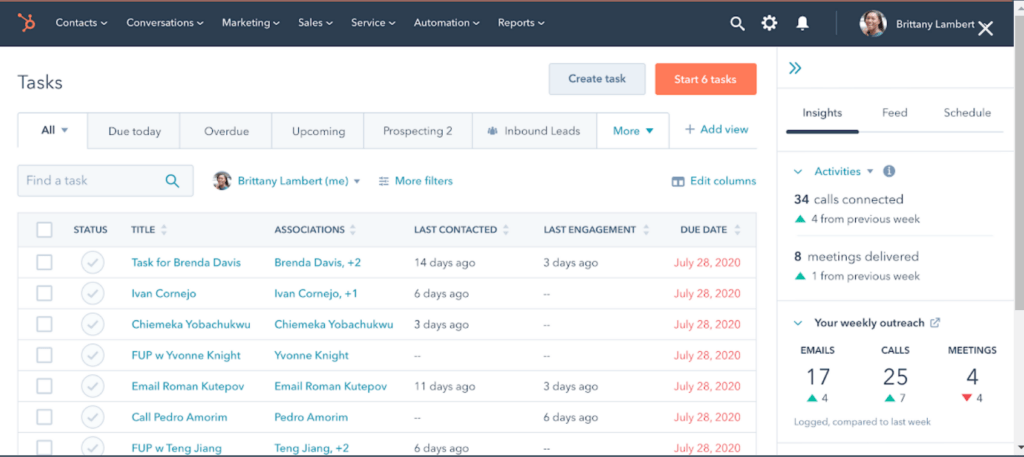
Is Front pricing a good investment for your company? Which other tools can you use to streamline your workflow?
From internal communications to sales and marketing, email is a key factor in today’s workplace. In fact, according to Gmail stats, the average worker gets 121 emails per day. That means your inbox should work for you, not against you. Many tools market themselves as a way to declutter and streamline your email, but do they work? In this article, we will explore one of them: Front. Let’s dive into Front pricing, the features available and, if that doesn’t work for your workspace, some other options that will.
What you need to know about Front
Front is a software developed to streamline your conversations with customers. It’s a platform that allows agents to develop more efficient connections with their client base and it covers the whole process. From sales pitches to customer support, this platform has been used across industries to avoid inbox overwhelm and foster collaboration.
At its core, Front aims to centralize communication to distribute it to the right channels. That is, instead of having to switch apps and lose momentum between tasks (aka, context-switching), they’re all there. Email, voice channels, social media and other platforms are all integrated.
On the flip side, it works by sending the message to the right person or department. That way, you avoid the dreaded CC and BCC email threads and the customer reaches who they actually need.
The best Front resources
Front has been popular among professionals because it offers interesting tools to enhance productivity and kill inbox clutter. That is, a lot of companies invest in Front pricing even if it’s not the least expensive option because these tools can be a huge timesaver in the office.
Omnichannel inbox
Are you tired of having to go through multiple platforms and digital spaces to fulfill your customer’s requests? A lot of communication is done through email, but there are other channels you need to look into. Most companies have a social media presence that brings inquiries, for instance. E-commerce websites probably have a live chat pop-up that allows potential new customers to contact the team.
However, monitoring and responding to all these inquiries can be time-consuming. This is where a multi-channel inbox management tool becomes useful. Front offers a centralized dashboard with incoming messages from all of your channels. Now you won’t miss any inquiries and your customers get their response faster.
Conversation history
Some companies offer multiple products to their customers and those come with their own set of challenges. But how do you know what your client needs? A conversation history feature is Front’s answer to this question. Part of what makes Front pricing worth it for some companies is the ability to review previous conversations in one click. That is, when you have a new message from your customer, you can go back and check other interactions to understand what they have bought, check for any previous issues and direct them to the best solution.
For example: your company offers two different versions of a sales management system. One is tailored to crafters, the other to service providers. When a customer messages you about an app glitch, you need to understand what version they have and how the issue affects their work. Or if your company is an e-commerce and deals with stocking: if customers message frequently about specific manufacturers, you might need to look deeper into it.
The Front conversation history is a snapshot of your relationship with your customer and includes previous interactions. If the client is reaching out to talk about an unsolved issue, you will see the previous tries. That way, you avoid wasting time with dead ends.
Message routes
This is probably the crucial tool that often justifies Front pricing. Message routes are automated rules that establish who gets a customer’s message and when. These rules are based on many factors, such as availability, user roles and keywords. But the basic idea is that messages are delivered to the best person to respond to them.
So if a customer emails you about implementing your software, they get the IT specialist. If someone is inquiring about prices, they can chat directly with sales. And that happens automatically with set rules. So you don’t have to forward emails to collaborators and add relevant attachments. With Front, they reach the right person’s dashboard instantly.
Front reviews: what users say
Do you want to know what users have to say about Front pricing, features and resources? Here are some of their thoughts!
Front has made communicating with customers a quick and easy process. It makes organization of projects and business scheduling simple.
Front customer review on G2
Front is a real game-changer for my team! We can effortlessly work together, handle customer inquiries quickly, and boost productivity, thanks to its amazing features like unified inboxes, automation, and collaboration tools.
Logistics coordinator review on G2
Front pricing tiers can be rough. I’m also capped at 10 accounts on the current pricing tier, so if I grow at all there’s going to be a very large incremental jump in cost.
Front pricing breakdown
Front can be more or less of an investment, depending on which features you’re looking for. To understand the difference between the plans and find out which tier works best for you, here’s a breakdown:
Starter
$ 19
user/month- 2 – 10 users
- Email, chat and social channels
- Shared inbox and drafts
- Email assignments
- Standardized rule templates
Growth
$ 59
user/month- From 5 users
- Email, chat, voice and social channels
- Shared inbox and drafts
- Email assignments
- Rules from company data
Scale
$ 99
user/month- From 20 users
- Email, chat, voice and social channels
- Shared inbox and drafts with user roles
- Dynamic assignments with shifts
- Custom rules
- 24-month data history
- Account and company analytics
Premier
$ 229
user/month- From 50 users
- Email, chat, voice and social channels with AI assistance
- Shared inbox and drafts with user roles
- Dynamic assignments and shifts
- Custom API builder
- Unlimited data history
- Up to 10 knowledge bases with 10,000 articles
- Extra customer onboarding process
Routes and data
Message routes are a key resource from Front and that means users will prefer a plan that includes it. It’s worth noting that the Starter plan doesn’t offer live chat context routing. This feature, present only on the Growth plan and above, categorizes chat messages based on which page the visitor was on.
The Growth plan also offers routing assignments based on CRM data, such as specific clients and subjects being directed to an agent, with workload distribution systems. However, these rules are limited to standard templates. For custom rules, you’d have to pick the Scale or Premier plan.
CSAT
Customer satisfaction has to be tracked to monitor customer service success. But it’s not always easy to do it, especially when working across platforms. CSAT surveys, scores and analytics are only available from the Growth plan and beyond. The conversation history, a crucial part of Front, is also available on more expensive plans only.
Team and company analytics
The Growth plan offers team performance reports. but they are limited to one group. With the Scale plan, you can also track your entire company across different departments, channels and expertise. This allows for a better view into the workflow as a whole, but also helps you notice any issues before they develop into bigger risks.
History and knowledge base
While any company can find success using the tools Front offers, there are limits. One of the reasons the Premier plan is highly valued is that it offers unlimited customer and activity data. Without a time or space limitation on previous interactions, your company has a better understanding of any issues and the solutions previously offered.
In a way, this helps you build a knowledge base, a guide on how your products work, any problems found and fixes implemented. That is very useful as an internal guide for any future company and product development strategies.
However, it’s also efficient as a way to help your clients. The Premier plan allows you to build up to 10 knowledge bases with 10,000 articles in 5 categories. This means a lot of useful information is available both internally and to your customers. With this resource, you can build easily accessible learning tools while growing the company itself.
Front pricing alternatives: which factors are key
Before you pick a Front alternative, it’s important to understand each tool’s limitations and user experience. Here are some factors to look into:
Format and different views
Some email and multi-channel management tools offer a central dashboard system. That means all of your messages are brought into the same digital space. Front, for example, duplicates the incoming messages for each assigned user, allowing all team members to receive communication that fits their expertise and schedule.
However, there are other, more efficient ways to view your incoming messages. Using a shared inbox tool for customer support, for example, allows users to view all incoming messages in real-time, even the ones that are not assigned to them. Instead of having to manually update collaborators on each task, all users can see the progress from their own digital workspace.
Integrations
Not all platforms are able to work together. In fact, one of Front’s limitations is that the least expensive plan, Starter, doesn’t offer Salesforce and Zapier integration. It’s important to note which tools are important to your work and find software that meshes well with them.
Cost and user limits
Naturally, the main concern is Front pricing. It doesn’t offer a free version and the least expensive plan is $19/user/month. The second problem, however, is with user limitations. Even as a paid plan, the Starter only allows up to 10 users. Entrepreneurs might be ok with it, but most small businesses would outgrow this quickly, especially when including different departments.
So when picking a new software, it’s important to check if it offers a free version and what are the limitations on the first pricing tier.
Turn Gmail into your Team’s Workspace.
- 2.5x faster email responses.
- 20 hours less spent per month, per team member.
- 40% more deadlines achieved and happier teams.
Top 5 alternatives to Front: pricing and tools
Front pricing can be out of budget for many smaller companies. Especially if they require more than the 10 setas allowed on the Starter pricing tier. Not to mention, sometimes there are features you don’t even need, which lead to a more expensive product with a bigger learning curve.
That’s why you should explore Front alternatives. That way, you can pick the tool that most aligns with your workflow needs and your budget constraints.
DragApp
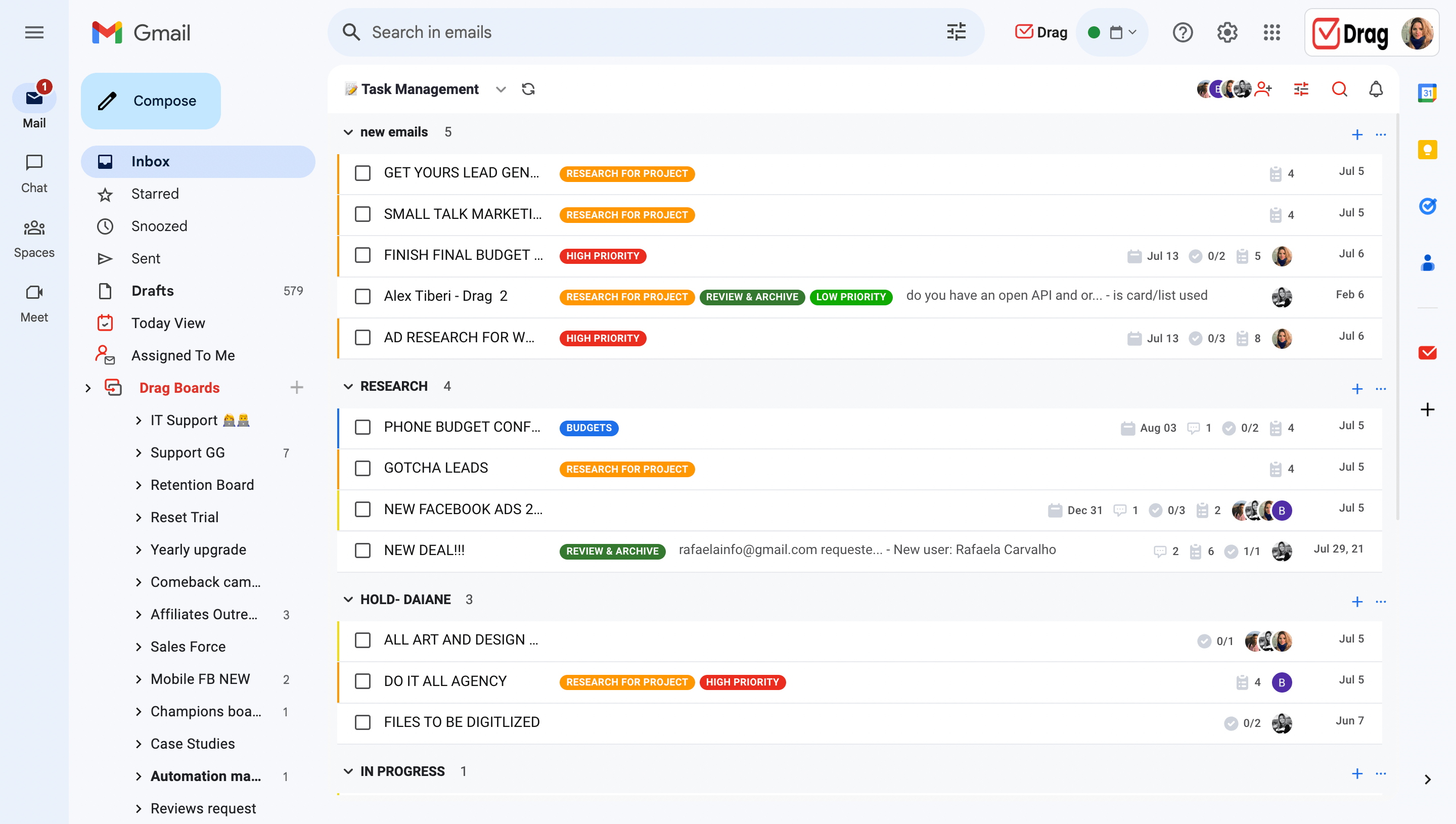
DragApp is a great option against Front pricing. Instead of viewing emails solely in inbox view, you can switch to Kanban project management mode, which transforms your workspace into a board with task cards. That way, the entire team can track the progress, add context and @mention collaborators. When a task moves into the next phase, you just drag it to the next column.
Capterra review: 4.4 stars
Price: From $8/user/month (free version available)
Main features
- Shared inbox: real-time collaboration
- Auto-replies: save time and create rules for quick responses to your customers
- Shared drafts: work together before you respond
- Email assignments: delegate messages to each team member
Freshdesk
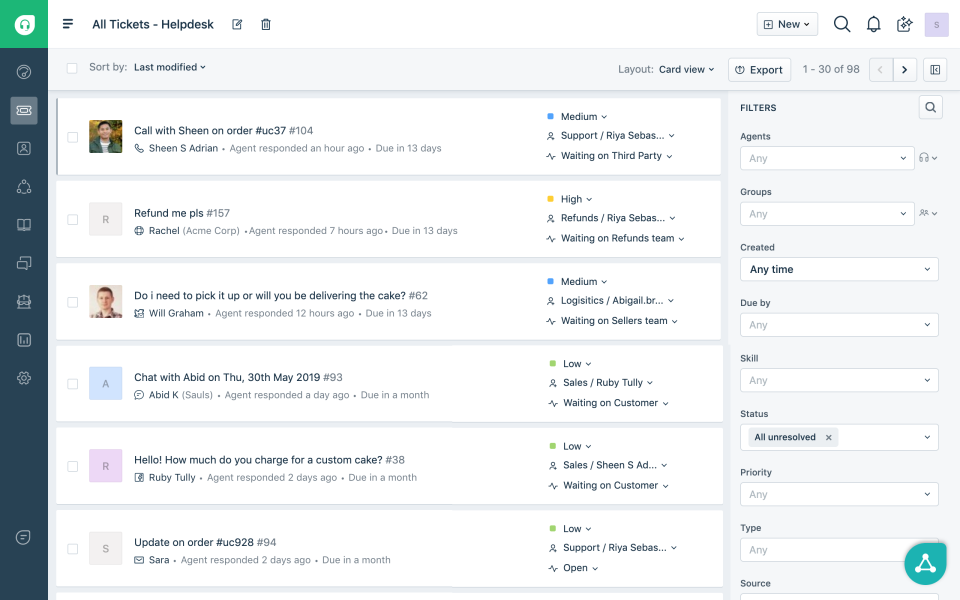
With Freshdesk, users can create a better digital workspace to chat with potential and existing clients. With this tool, you can fulfill existing tickets efficiently. There’s also a knowledge base builder, which helps you develop a self-service portal in which your customer can find the answer 24/7.
Capterra review: 4.5 stars
Pricing: from $15/user/month (limited free version available)
Main features
- Customer context: with a conversation history, you can track your recipient’s previous concerns
- Assignment system: rules determine which tasks are urgent and will get distributed faster
- Remote access: keep working across devices
- Tracking notes: add internal notes to conversations to monitor progress and contextualize the tasks
Groove
Groove can be a helpful tool for different kinds of customer service teams, due to its flexibility. A dashboards connects different support channels, such as email and social media, while showing KPI metrics and offering insights into conversations. That way, the entire team can be kept up to date on current issues.
Pricing: from $12/user/month up to 5 users (free trial available)
Main features
- Ticket routes with automation
- Collision detection
- Message templates
- Business hours rules and automations
HelpScout
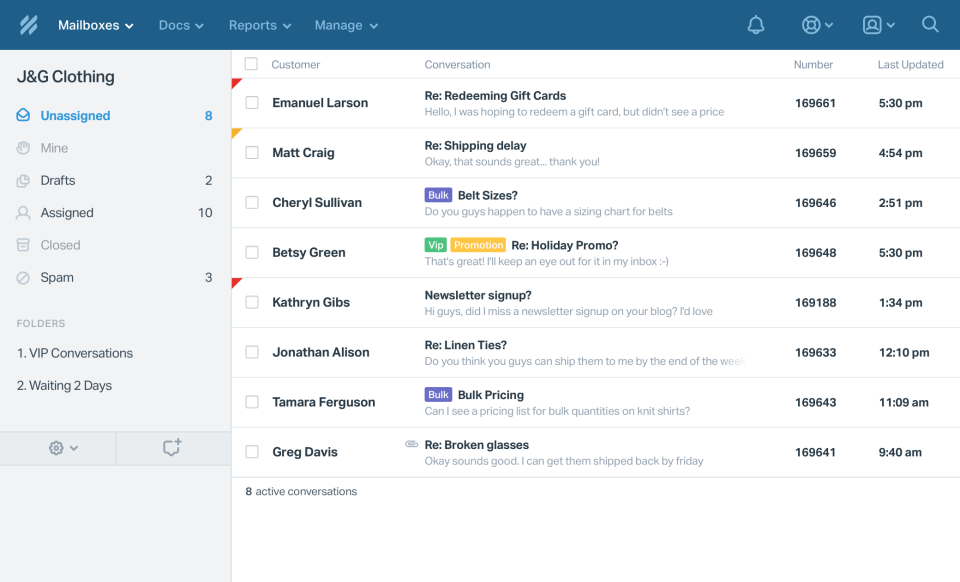
With HelpScout, you also get a multi-channel dashboard, which makes it a great option if you’re looking for a Front pricing alternative. With over 100 third-party integrations, it’s easy to solve any client concerns and convert more sales from one single place.
Capterra review: 4.6 stars
Pricing: from $20/user/month (15-day free trial available)
Main features
- 2 shared inboxes on the starter plan
- Social media integration
- Startup and B-Corp friendly
Hubspot
Hubspot’s Service Hub is an add-on to other apps from the developers, such as the Sales and CRM tools. As such, it helps teams manage the customer service pipeline, from social media to voice channels. The dashboard centralizes and redirects inbound messages and helps you manage task assignments.
Capterra review: 4.4 stars
Pricing: there’s a free version available and paid plans start at $45/month
Main features
- Customer portal: client-facing dashboard where users can see their ongoing chats with customer support
- Live chat: find your customers where they are, across all platforms
- Build your digital workspace: Hubspot offers a helpful system that covers the whole pipeline, from sales and marketing to an internal operations hub. Managers can add different apps to their plans according to the company’s specific needs
Setting up your workflow
While the platform can be useful and resourceful, is Front the best option for small companies? The main concern is that Front pricing is higher than the alternatives, which can disrupt budget limits. This is why exploring other tools can be a great way to find the one that fits your needs better.
Of course, there’s no set answer. The process requires analyzing your team’s workflow, noting the main bottlenecks and where the agents lose their productivity. It can be switching between platforms or having to write detailed responses to each inquiry.
Then, you should note which resources are key to streamlining the workflow. Perhaps implementing shared drafts would lead to quicker responses. Or your customer base requires a well-categorized knowledge base. Team management is an important factor as well: some of these tools offer specific task assignment systems that can be useful for different types of teams.
Then, after picking out the software that most aligns with your goals, start your trial to understand how it works and it if would truly help. Look for apps that offer a quick, efficient onboarding with a low learning curve. Drag uses a Gmail shared inbox to build a helpdesk system, for instance, which means you already know how to use it.
The last step is to explore the different features. The apps above offer a variety of learning tools, from demos to user forums. With personalization and habit, the Front alternative you choose will be the ideal workspace for you.
Turn Gmail into your Team’s Workspace.
- 2.5x faster email responses.
- 20 hours less spent per month, per team member.
- 40% more deadlines achieved and happier teams.


